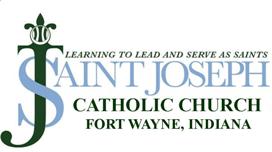|
|
|||||||||||||||
 |
|||||||||||||||
|
History of Saint Joseph the Worker
Catholic Church
By Pauline Eversole St. Joseph Catholic Church evolved through the work and guidance of Mr. Loreto Starace. Starace was of Italian descent, born in Naples, Italy in 1884. It’s unclear what brought Mr. Starace to Fort Wayne, Indiana, but he felt a calling to work as a lay apostle and establish a church for the Italian speaking people of the city. There were many Catholic churches to serve different nationalities in the city at that time, but none for the Italian people. That led to a language barrier that precluded the people of Italian descent from going to confession and receiving the Sacraments. Mr. Starace appealed to Bishop Herman J. Alerding, which resulted in the appointment of Father Loreto Monastero. Father Loreto’s task was the establishment of an Italian Catholic parish. The first meetings were held in downtown Fort Wayne at the Library Hall building located on the Cathedral Square. When Father Monastero began complaining that he felt the establishment of the new church failed to progress as quickly as he had hoped, he requested a change of venue, which he received. Monastero moved to Chicago. Starace had an old friend, Father Antonio Petrilli who at the time was assisting with a parish in Chicago. Starace approached Bishop Alerding and requested that Fr. Petrilli be sent to Fort Wayne to continue the project. When Fr. Petrilli arrived in Fort Wayne it was with three of his close friends, all tailors by trade, Dominick Landolfi, John Petrilli and Paul Cimini. Together with Starace, they continued the mission to begin an Italian-speaking Catholic Parish. Others of Italian descent soon joined the small troop going door-to-door to spread the news of the new church, to recruit new members and to solicit funds. Eventually there was enough money to rent a two-story house located on the corner of Fairfield Avenue and Bass Avenue. The downstairs was utilized for the church while the upstairs served as a rectory. The new mission church was furnished through the solicitations of furnishings and funds from the wealthy friends of Mrs. Zuber of Zuber’s Variety Store. Starace returned to Italy in 1914 when World War I was endangering the entirety of Europe. There were protests from his many friends but Starace persevered and returned to his homeland of Italy where he thought he belonged. Fr. Petrilli forged onward without the support of his good friend in his endeavors for a church building for his small congregation. Finally convinced, Bishop Alerding purchased property on the corner of Frary and Taylor Streets. The first St. Joseph Catholic Church built was a white frame building with a basement, a sacristy and a choir loft. Through the generosity of the congregation the church building had large stained-glass windows, a rectory, a convent and a portable schoolhouse. The church was dedicated on October 8, 1916. The celebration included fireworks made by the men of the congregation. However, St. Joseph Church did not remain a primarily Italian-speaking parish for long. Between 1919 and 1923 there was much disappointment and upheaval for the laboring parish. Bishop Aldering declared St. Joseph would be a parish church to be utilized by all Catholics in the area. Thus, the church was no longer strictly for Italian-speaking people. Fr. Petrilli returned to his home in Italy and was replaced by Fr. Vurpillot. The newly appointed priest had many clashes with his parishioners. On April 10, 1921, an announcement was made at Sunday mass and also appeared in the newspaper declaring the Bishop had sold the property of St. Joseph’s Church to Westfield Presbyterian Church. According to church history, Fr. Vurpillot had reported to the Bishop the parishioners were not supporting the parish. The debt for St. Joseph Church at the time was $19,000. The Bishop had always been apprehensive about the church’s financial stability. Therefore, Fr. Vurpillot’s report was the motivation for the sale of the building and all the furnishings. The parishioners were crushed by the loss of their beloved church. A committee was formed to begin resolving the numerous misunderstandings. In 1923 a final resolution was obtained. Land was purchased on the corner of Brooklyn and Hale Avenues in 1924 and a brick combination church and school was built. The two houses on the property were converted for use as a rectory and a convent. The parish had a difficult start but finally started to make real progress. In 1960, the combination school and parish was demolished making room for a new church. St. Joseph Church faced another substantial challenge in the late 1980’s when St. Elizabeth Ann Seton parish was established on the southwest side of Fort Wayne. Numerous families from St. Joseph were part of the formation of the St. Elizabeth Ann Seton parish. The two parishes now use St. Joseph School facilities and St. Elizabeth Ann Seton parish facilities to share in a joint school effort. Since the split off of the St. Elizabeth Ann Seton parish, St. Joseph parish is currently undergoing liturgical growth and renewal, updating and rebuilding the parish. Music and liturgy are expanding to include a variety of musical styles at the different masses to reach the needs of different age groups and preferences. The RCIA program has taken on a dramatic renewal in its approach to the Sacraments of Baptism and Confirmation, and overall the parish is focusing on being a welcoming community to its own members, to the unchurched, and to those who may have stopped coming to church. |
|||||||||||||||